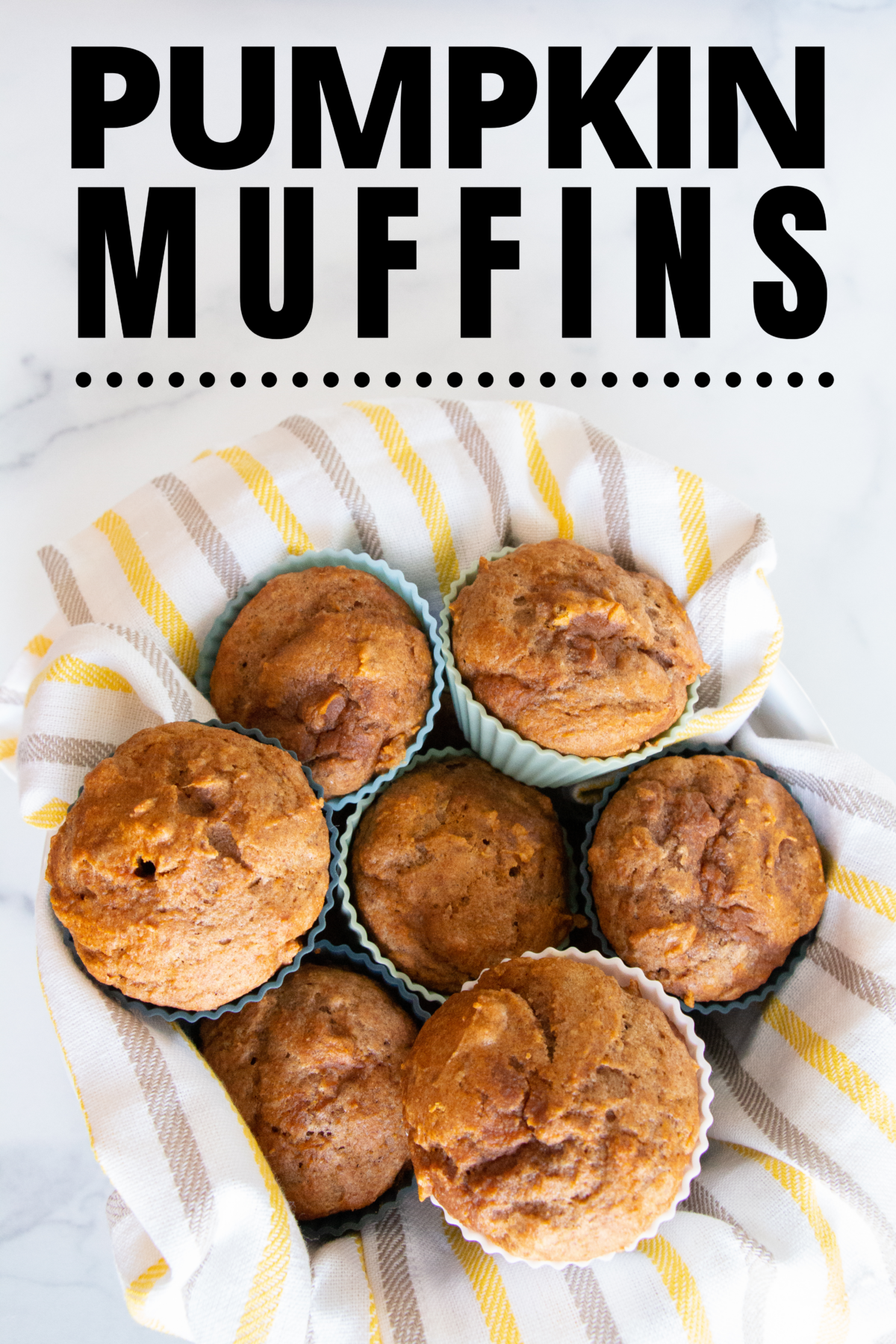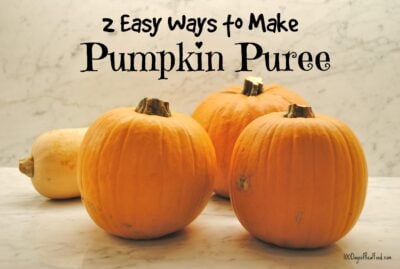Healthy Pumpkin Muffins – 100 Days of Real Food
I finally did it! I’ve been wanting to bake with some alternative flours for some time, and this weekend I finally made this pumpkin muffin recipe using whole spelt flour. And I must say, they are deeeelicious! We’ve definitely been missing out … the texture is much more cake-like and the taste is milder than regular whole-wheat flour.
It was super easy to make the 1:1 substitution … I have no idea why I kept putting it off! But if you don’t have spelt flour you could definitely use whole-wheat pastry or regular whole-wheat flour instead.

Baking Tips
This recipe is super simple to make and it would be really fun to kids to help out. Best of all, you can make the batter in just one bowl—less to clean up! I recommend making a double batch of muffins to have ready in your freezer for a quick breakfast or school snack on busy days.
You can also bake these in mini-muffin tins if you’d like (be sure to check them at around 10 minutes) or bake them in festive muffin cups or paper liners depending on the holiday or season.

What Makes These Pumpkin Muffins Healthy?
Whole Grain Flour
Spelt may sound like a “new” grain (at least it did to me), but it’s actually been around for more than 9,000 years. As I mentioned, the flavor is “lighter” than wheat and even though it contains gluten, some with an intolerance to wheat find that they are able to enjoy spelt.
Just like with wheat though, you want to be sure to select “Whole” spelt products as opposed to the refined (white) version. And to keep your whole spelt flour fresh, it’s best to stick it in the freezer (or fridge) along with your other whole grain flours.
Natural Sweeteners
When it comes to sweeteners, I use the least processed sweeteners available, which are honey and 100% pure maple syrup. You won’t find any refined sugar in these muffins. But, like with any recipe that calls for sugar or sweeteners, moderation is key … because “sugar is sugar” no matter how you look at it (learn more in my “Sweeteners 101” post).
Can I Use Halloween Pumpkin?
The simple answer is yes. Once you’re done carving your pumpkin for Halloween you can turn it into pumpkin puree, but there are some major differences between your jack-o-lantern and a “pie” pumpkin that you might want to consider.
One of the most common methods of homemade pumpkin puree is roasting it, so a large Halloween pumpkin might not be the best size to fit in your oven. They are also a lot more stringy and have less flesh than the baking ones. And from my experience, the flavor just isn’t the same since carving pumpkins have less natural sugar, resulting in less sweetness for those yummy fall desserts.
By all means, you can still turn those festive Halloween pumpkins into a puree if you’d like, but I definitely recommend using a smaller pie pumpkin for the best outcome. Whichever you choose, try one of these two simple methods we explain in this post.
Pumpkin Puree Tip
If you use canned pumpkin, make sure you purchase a can of pumpkin puree and not pumpkin pie filling. While they may seem similar, pumpkin pie filling is a blend of squash, sweeteners, and spices—and I’ve already mentioned how I like to stay away from refined sugars!
What Is Pumpkin Pie Spice?
Whether it’s the famous Pumpkin Spice Latte or a holiday Pumpkin Pie at Thanksgiving, the main flavor is Pumpkin Pie Spice. This fall flavor is generally a blend of cinnamon, ginger, nutmeg, cloves, and sometimes allspice. You can find a variety of store-bought blends or easily create your own using these measurements (makes about three ounces):
- 3 tablespoons ground cinnamon
- 1 1/2 tablespoons ground ginger
- 1 tablespoon ground nutmeg
- 1 teaspoon ground allspice
- 1 teaspoon ground cloves
How to Store Pumpkin Muffins
After you’ve let the muffins cool completely on a wire rack, transfer them in a single layer into an airtight container and store them at room temperature for up to 4 days.
If you’re worried about soggy muffins, one trick is to line the bottom of the container with a paper towel, add the muffins, then place another paper towel on top. This is supposed to help absorb any moisture, resulting in your muffins staying fresher, longer.
As I mentioned before, I always make a double batch of any kind of muffins to store in the freezer. They are a great time saver for school lunches, on-the-go breakfast, or snacks.
For these pumpkin muffins, or any bread item, there are two ways you can freeze them:
- Freeze them in one layer on a baking sheet. Then once they are frozen, transfer them to a big Ziploc bag or other freezer-safe containers.
- Eliminate a step by separating the layers of food with pieces of wax paper in your freezer-safe container/bag (so nothing sticks together). With certain foods (like muffins) I find that I don’t even need the wax paper.
I recommend only storing them for up to 6 months this way. When you’re ready to enjoy them, take your desired amount out of the freezer the night before and let them defrost in the refrigerator overnight, or on the counter at room temperature. If you’re in a hurry, you can always pop it in the microwave for a few seconds, too.
Video: How to Make Pumpkin Muffins
I was in LA and got to visit Catherine McCord (of Weelicious) in her kitchen where I showed her how to make these muffins. Check it out in the video below!
More Pumpkin Recipes
More Muffin Recipes

Healthy Pumpkin Muffins
These pumpkin muffins are easy, healthy, and delicious with a cake-like texture (the secret is in the ingredients!). Perfect for the holidays or anytime.
Servings: 12 muffins
Nutrition Facts
Nutrition Facts
Healthy Pumpkin Muffins
Amount Per Serving
Calories 107
Calories from Fat 54
% Daily Value*
Fat 6g9%
Saturated Fat 4g25%
Cholesterol 41mg14%
Sodium 245mg11%
Potassium 71mg2%
Carbohydrates 14g5%
Fiber 1g4%
Sugar 12g13%
Protein 1g2%
Vitamin A 3375IU68%
Vitamin C 1.1mg1%
Calcium 19mg2%
Iron 0.6mg3%
* Percent Daily Values are based on a 2000 calorie diet.





